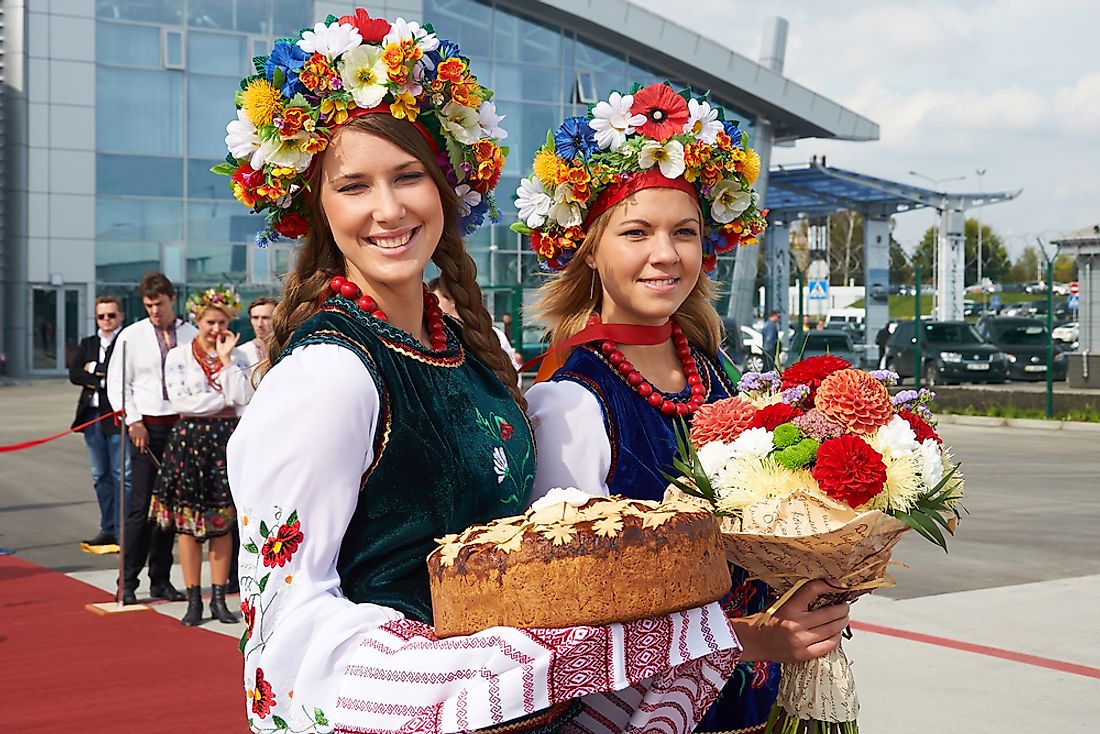Major Ethnic Groups Of Ukraine

After achieving its independence in 1991, Ukraine has been tasked with uniting its various regions and creating a distinct national identity. As the country is home to more than a hundred different nationalities, this presents some complex and significant challenges.
Ethnic divisions in Ukraine go back to the imperial period when regional borders were heavily disputed by Russia, Austro-Hungary, and the Polish-Lithuanian Commonwealth. Southeast Ukraine has historically been populated by ethnic Russians and Russian-speaking Ukrainians, with close cultural and economic ties to Russia. Much of western Ukraine was part of Habsburg Austria until 1918; while other regions were brought into Ukraine after World War II, and the area maintains strong ties with Europe.
Roughly 77.5% of Ukraine's population identify as ethnic Ukrainians. The second largest nationality group are Russians, accounting for 17.2% of the population. Other significantly represented nationalities include Romanians, Belorussians, Crimean Tatars, Bulgarians, Hungarians, Poles, Jews, and Armenians.
Russian
The Russian community in Ukraine is primarily located in Crimea. The Russian Empire captured and began to colonize the largely uninhabited steppe territories in the former Crimean Khanate in the late 18th century. The discovery of coal in the Donets Basin sparked large-scale industrialization and an influx of laborers from other parts of the Russian Empire. During the Russian Civil War, Ukraine became a battleground between the Communist Red Army and the Monarchist Volunteers. Ukraine became the Soviet Socialist Republic in 1992, and in a 1997 treaty between the two countries, Russia agreed to recognize Ukraine's current borders.
Romanian
In 1918, Bukovina and Bessarabia were united with the Kingdom of Romania. Ukrainian population in the region were forced to change their names, their languages, and Ukrainian schools and cultural institutions were closed. After the Russian Civil War, the area was annexed by the Ukranian SSR. A 1997 treaty guaranteed the rights of Romanians in Ukraine.
Belorussian
Most Belorussians emigrated to the Ukrainian SSR during the Soviet Union. Unlike most other ethnic groups, they are spread fairly evenly throughout the country. Belorussian nationals have reportedly been divided between both sides during the recent conflict in Ukraine.
Crimean Tatar
Crimean Tatars are descended primarily from Turkic tribes who emigrated to Eastern Europe from the Asian steppes from the 10th century onward. The entire population was deported to Uzbekistan in 1944. Today, more than 250,000 Crimean Tatars have returned to their homeland, now part of Ukraine, and struggle to reclaim their heritage, as well as national and cultural rights.
Bulgarian
Many Bulgarians settled in what is now the Odessa Oblast during the Ottoman Empire and after the Russo-Turkish Wars in the 18th and 19th centuries. The area changed hands several times: divided between Russia and Romania, ceded to Russia in 1878, recaptured by Romania in 1918, and then it became part of the Soviet Union.
Hungarian
Ukraine's territory of Zakarpattia was originally part of the Kingdom of Hungary. Disputed over by Romania, Ukraine, and Hungary, it was awarded to the newly formed Czechoslovakia before being incorporated into the Ukrainian SSR. A 1991 treaty guaranteed the rights of Hungarians in Ukraine, although dual citizenship is not officially recognized.
Polish
In the 16th and 17th centuries, Poland sponsored large-scale Polish colonization of central and eastern Ukraine. After the fall of Austro-Hungary, the Polish population successfully rebelled against the newly-formed West Ukrainian government. During the Soviet era, Poles were deported to Siberia, and a campaign of ethnic cleansing was carried out by Ukrainian nationalists.
Jewish
Jewish communities have existed in Ukraine for more than a thousand years. According to the World Jewish Congress, the Jewish community in Ukraine constitutes the third biggest Jewish community in Europe and the fifth biggest in the world. Massacres and pogroms frequently took place in the 19th and 20th centuries. The majority left Ukraine after the fall of Communism, but antisemitism continues to be problematic for the remaining population.
Armenian
The Armenian population in Ukraine has nearly doubled since the end of the Soviet Union. They still maintain close ties with Russia: 50% are native Armenian speakers, but over 43% speak Russian, and only 6% speak Ukrainian as their first language.
Ethnic minorities bring to Ukraine a rich and diverse cultural heritage. However, integrating them into a united Ukraine will require careful planning and implementation of government policies.
Major Ethnic Groups Of The Ukraine
| Rank | Ethnic Group | Share of National Population of Ukraine |
|---|---|---|
| 1 | Ukrainian | 77.5% |
| 2 | Russian | 17.2% |
| 3 | Romanian | 0.8% |
| 4 | Belorussian | 0.6% |
| 5 | Crimean Tatar | 0.5% |
| 6 | Bulgarian | 0.4% |
| 7 | Hungarian | 0.3% |
| 8 | Polish | 0.3% |
| 9 | Jewish | 0.2% |
| 10 | Armenian | 0.2% |











